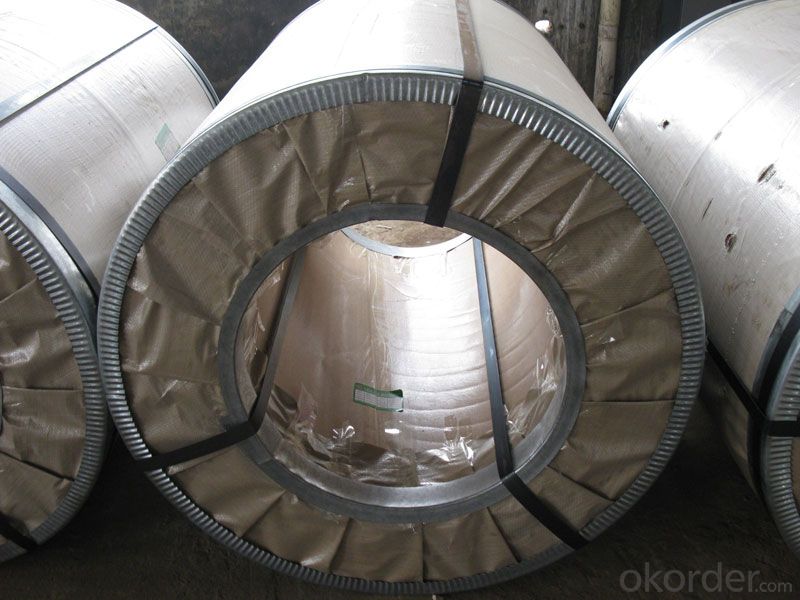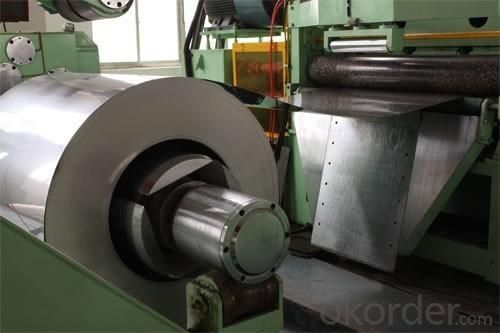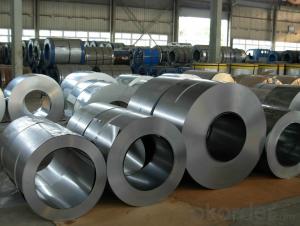Chinese Best Cold Rolled Steel Coil--Any type in Good Quality
- Loading Port:
- China main port
- Payment Terms:
- TT OR LC
- Min Order Qty:
- 50 m.t.
- Supply Capability:
- 10000 m.t./month
OKorder Service Pledge
OKorder Financial Service
You Might Also Like
Chinese Best Cold Rolled Steel Coil--Any type in Good Quality
1.Structure Description:
The raw material of cold rolled steel coil/sheet is high quality hot rolled product, and after pickling continuous rolling, degreasing, annealing,skin pass,slitting and cut to length line etc. Along with it many kinds of new technology and new process of global cold rolling production have been applied. Therefore the quality of the goods could be guaranteed.
2.Main Features of the Cold Rolled Steel:
• Excellent process capability
• Smooth and flat surface
• Workability, durability
• High strength
• Good visual effect
3. Cold Rolled Steel Images


4.Cold Rolled Steel Specification
Standard:AISI,ASTM,DIN,GB,JIS,JIS G3302 ASTM 653M EN10142
Grade: Q195~Q345
Thickness: 0.16mm~2.0mm
Width: 1250mm MAX
Coil weight:3-12 MT
5. FAQ of Cold Rolled Steel
1.How to guarantee the quality of the products?
We have established the international advanced quality management system,every link from raw material to final product we have strict quality test;
2. How long can we receive the product after purchase?
Usually within thirty working days after receiving buyer’s advance payment or LC. We will arrange the factory manufacturing as soon as possible. The cargo readiness usually takes 15-25 days, but the shipment will depend on the vessel situation.
- Q:Are steel coils used in construction?
- Yes, steel coils are commonly used in construction. They are used for various applications such as structural framing, roofing, walls, and other components in buildings and infrastructure projects. Steel coils provide strength, durability, and flexibility, making them a popular choice in construction.
- Q:also what are the factors of location of these steel plants
- iron ore comes from mines in North America, but also abroad. I think the majority of ore comes from mines in Michigan, Minnesota, and Canada. reason that steel plants are near great lakes is because the car industry is there... they are the major consumer of steel...
- Q:can anyone tell me the way to bring back the shine to the stainless steel kitchen sink . It has become dull.
- these stainless steel are easy clean and polish so you can purchase online these website given as below: www.gecanderson .uk/product/made-to-measure/shelving/
- Q:How are steel coils used in the aerospace industry?
- Steel coils are used in the aerospace industry for various applications such as manufacturing aircraft components, including structural parts, engine components, and landing gear. These coils are often processed and formed into sheets, plates, or other desired shapes to meet the specific requirements of aerospace engineering. The high strength and durability of steel make it an ideal material for withstanding the demanding conditions and stresses experienced by aircraft during flight.
- Q:How are steel coils used in the production of metal cladding?
- Steel coils are used in the production of metal cladding as they are rolled into flat sheets and then formed into various shapes and profiles. These coils provide the raw material for manufacturing metal cladding panels, which are widely used in construction for their durability, weather resistance, and aesthetic appeal.
- Q:How are steel coils uncoiled?
- Steel coils are uncoiled using a mechanical process called decoiling, where the coil is placed on a mandrel and then unwound using a motor-driven system. The coil is pulled through a set of straightening rolls to ensure it is properly aligned and then fed into the production line for further processing or fabrication.
- Q:I was looking at my Great-Grandfather's immigration form from when he immigrated from Scotland and he listed his occupation as a steel dresser. What does a steel dresser do?
- The steel dresser was a person who would clean the freshly made cast steel pieces at a foundry/ steel factory. Usually when the steel comes out it will have some extra bits and pieces sticking out that need to be removed. The steel is melted and cast into shape so there will be like a little raised line where edges of the mold met or a few blobs sticking out where the hot steel dripped over the edge or something. The dresser was the person who got rid of that kind of stuff to make a more finished/even product.
- Q:How are steel coils inspected for hardness?
- Steel coils are inspected for hardness using various methods to ensure their quality and suitability for specific applications. One common method is the Rockwell hardness test, which involves pressing a diamond or ball indenter into the surface of the coil and measuring the depth of indentation. The hardness value is then determined based on the depth measurement. Another method used is the Brinell hardness test, which employs a hardened steel or tungsten carbide ball indenter to create an indentation on the coil's surface. The diameter of the indentation is measured, and the hardness value is calculated using a formula based on the applied load and the diameter of the indentation. Vickers hardness test, on the other hand, uses a pyramidal diamond indenter to create an indentation on the coil's surface. The indentation diagonal lengths are measured, and the hardness value is calculated using a formula based on the applied load and the diagonal lengths. Apart from these traditional methods, modern technology has introduced non-destructive testing techniques such as ultrasonic testing and eddy current testing. Ultrasonic testing involves transmitting ultrasonic waves through the coil and measuring the time taken for the waves to return. Changes in the wave pattern can indicate variations in hardness. Eddy current testing uses electromagnetic induction to detect changes in electrical conductivity, which can be correlated to hardness variations in the steel coil. Overall, steel coils undergo rigorous inspection processes using a combination of traditional and advanced techniques to ensure their hardness meets the required specifications. These inspections play a crucial role in maintaining the quality and reliability of steel products in various industries.
- Q:I need to say how a bottle opener is made, would it be made from steel and can this be coloured? How?
- Steel can be plated(Chrome),Blackened(Black Oxide),Powder coated(color of your choose).All of this is done to prevent rust.All of these aforementioned processes can be worn off through being used.I suggest polished Stainless steel.
- Q:What are the different types of steel coil edge treatments?
- In the manufacturing and processing of steel coils, various steel coil edge treatments are employed. These treatments serve to improve edge quality, protect against damage, and facilitate the handling and processing of the coils. Some of the prevalent types of steel coil edge treatments are as follows: 1. Mill Edge: The steel mill provides this standard edge treatment, which is the raw edge of the steel coil generated during the hot rolling process. The mill edge is typically sharp and may exhibit some irregularities. 2. Slit Edge: Slit edge treatment involves slitting the coil to the desired width and subsequently processing the edges to eliminate any burrs or unevenness. Compared to mill edge coils, slit edge coils have smoother edges. 3. Deburred Edge: The deburring process removes any sharp or rough edges from the coil using specialized equipment or techniques, resulting in a smoother and safer edge. Deburred edges find common use in applications where safety and handling are of utmost importance. 4. Rounded Edge: Rounded edge treatment entails rounding the edges of the coil to minimize the risk of damage during handling and processing. This treatment is frequently employed in applications where the coil must be uncoiled or fed into machinery without incurring any damage. 5. Beveled Edge: Beveling involves chamfering or cutting the edges of the coil at an angle. Beveled edges are utilized in applications where easy insertion, joining, or welding of the coil is required. The beveling process also enhances the strength and durability of the edge. 6. Sheared Edge: Shearing is a cutting process that employs high-pressure blades or scissors to cut the coil to the desired width. Sheared edge treatment yields a clean and straight edge, devoid of burrs or irregularities. It is commonly employed in applications that necessitate precise dimensions and a smooth edge. These are merely a few examples of the various steel coil edge treatments commonly employed in the industry. The selection of edge treatment depends on specific application requirements, such as handling, processing, safety, and aesthetics.
1. Manufacturer Overview |
|
|---|---|
| Location | |
| Year Established | |
| Annual Output Value | |
| Main Markets | |
| Company Certifications | |
2. Manufacturer Certificates |
|
|---|---|
| a) Certification Name | |
| Range | |
| Reference | |
| Validity Period | |
3. Manufacturer Capability |
|
|---|---|
| a)Trade Capacity | |
| Nearest Port | |
| Export Percentage | |
| No.of Employees in Trade Department | |
| Language Spoken: | |
| b)Factory Information | |
| Factory Size: | |
| No. of Production Lines | |
| Contract Manufacturing | |
| Product Price Range | |
Send your message to us
Chinese Best Cold Rolled Steel Coil--Any type in Good Quality
- Loading Port:
- China main port
- Payment Terms:
- TT OR LC
- Min Order Qty:
- 50 m.t.
- Supply Capability:
- 10000 m.t./month
OKorder Service Pledge
OKorder Financial Service
Similar products
New products
Hot products
Related keywords





























